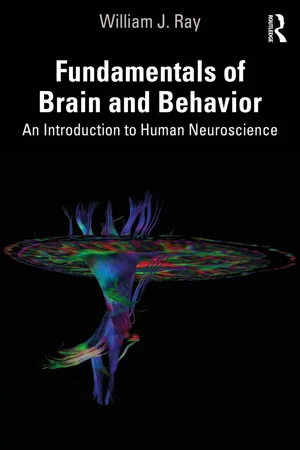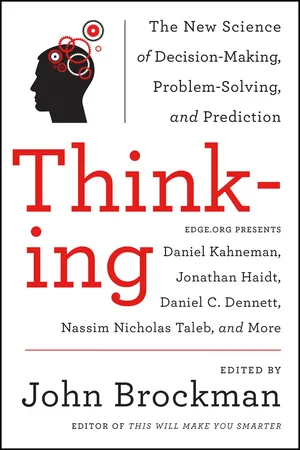Psychology
Studying the brain
Studying the brain involves investigating the structure, function, and processes of the brain to understand how it influences behavior, cognition, and emotions. This field of study encompasses various disciplines, such as neuroscience, cognitive psychology, and neuropsychology, and utilizes advanced technologies like brain imaging to explore the complexities of the brain and its impact on human experience and behavior.
Written by Perlego with AI-assistance
Related key terms
5 Key excerpts on "Studying the brain"
- eBook - ePub
Fundamentals of Brain and Behavior
An Introduction to Human Neuroscience
- William J. Ray(Author)
- 2024(Publication Date)
- Routledge(Publisher)
The methods of science help us to know not only when we are correct but also when we are wrong. An important aspect of this book is telling the story of how scientists came to learn about the brain and its neural processes. You will see how genes encode proteins that create structures during development which are critical to understanding the brain and behavior. You will also see how changes in technology allow us to image brain processes which influence behavior and experience. In addition, we will help you to understand how our evolutionary history has come to influence our brain and its methods of processing our experiences. For example, there has never been a time in our history as humans that we have not lived with others. This helps us to understand how social processes are critical to humans. At this point, there is an attempt to unify knowledge from the psychological sciences with those of the traditional neurosciences (Kandel & Shadlen, 2021). This allows for an understanding of not only basic human processes such as movement, speech, and human relationships but also difficult-to-study processes such as consciousness. Our Brain and Body Determine What We Do and Experience With the development of brain imaging techniques in the last few decades, observing brain activity with greater precision is now possible. In particular, we will note the structure and function of the brain as it relates to neuroscience. Structure refers to which brain areas or networks are involved in a given task such as feeling afraid. We know, for example, that when you process information that is emotionally important to you, a specific brain structure called the amygdala becomes active. We also know that particular networks of the brain are involved in processing faces and still others in understanding and producing speech. We can also ask how changes in processes such as learning change structure - eBook - ePub
- Mark J. Cain(Author)
- 2015(Publication Date)
- Polity(Publisher)
6The Brain and Cognition1 Introduction
What is the relationship between the brain and the mind or between neural states and processes and cognitive states and processes? And what are the implications of the nature of that relationship for the role of the study of the brain in cognitive science? The purpose of this chapter is to address these questions in the light of recent developments in neuroscience and the rising prominence of that discipline both in the scientific community and in the popular imagination.2 Neuroscience and the history of cognitive science
As we saw in chapter 1 , cognitive science was founded on the basis of the rejection of substance dualism and of behaviourism. Accordingly, the mind was viewed as a physical system internal to the body that mediated the connections between the world external to the body and bodily behaviour or action. Thus, for example, when a wild animal approaches a person and they respond by throwing a stone in the animal’s direction, that response is mediated by processes internal to the body that serve to identify the wild animal and work out the best way to respond to it given the person’s current goals. As a result of this processing, instructions are issued to the motor control systems so that the person behaves in line with their plans. It was also a foundational assumption of cognitive science that such internal processes take place in the brain, that the brain is the seat of cognition. Given this, one might have expected that neuroscience, the scientific study of the brain, would have played a prominent role in cognitive science throughout its history. However, this has not been the case for several reasons.The first reason why neuroscience has had only a limited role in the history of cognitive science is a practical one. Neuroscientists often point out that the human brain is the most complex system in known existence, being made up of 100 billion neurons, most of which are connected to thousands of other neurons, giving rise to a system with 100 trillion internal connections. This complexity makes the human brain a very difficult system to study. Not surprisingly, our scientific understanding of the workings of the brain has historically lagged way behind that of our understanding of other aspects of the natural world. The upshot of this is that, for most of the history of cognitive science, neuroscientists haven’t known enough about the workings of the brain to make much of a contribution. However, things are rapidly changing on this front, in no small part on account of the emergence of technologies that enable us to scan the human brain. - eBook - ePub
Thinking
The New Science of Decision-Making, Problem-Solving, and Prediction in Life and Markets
- John Brockman(Author)
- 2013(Publication Date)
- Harper Perennial(Publisher)
5Adventures in Behavioral Neurology—Or—What Neurology Can Tell Us About Human Nature
Vilayanur RamachandranDirector of the Center for Brain and Cognition and Distinguished Professor with the Psychology Department and the Neurosciences Program, University of California–San Diego; Adjunct Professor of Biology, Salk Institute; coauthor, Phantoms in the Brain; author, The Tell-Tale Brain.I’m interested in all aspects of the human mind, including aspects of the mind that have been regarded as ineffable or mysterious. The way I approach these problems is to look at patients who have sustained injury to a small region in the brain, a discipline called behavioral neurology or cognitive neuroscience these days.Let me tell you about the problem confronting us. The brain is a 1.5-kilogram mass of jelly, the consistency of tofu, and you can hold it in the palm of your hand, yet it can contemplate the vastness of space and time, the meaning of infinity, and the meaning of existence. It can ask questions about who am I, where do I come from, questions about love and beauty, aesthetics and art, and all these questions arise from this lump of jelly. It is truly the greatest of mysteries. The question is, how does it come about?When you look at the structure of the brain, it’s made up of neurons. Of course, everybody knows that these days. There are 100 billion of these nerve cells. Each of these cells makes about 1,000 to 10,000 contacts with other neurons. From this information people have calculated that the number of possible brain states, of permutations and combinations of brain activity, exceeds the number of elementary particles in the universe.The question is, how do you go about studying this organ? There are various ways of doing it. These days brain imaging is very popular. You make the person perform some task, engage in conversation or think about love, for that matter, or something like that, or imagine the color red. What part of the brain lights up? That gives you some confidence in saying that that region of the brain is involved in mediating that function. I’m sort of simplifying it, but something along those lines. Then there is recording from single cells, where you put an electrode through the brain, eavesdrop on the activity of individual neurons, and find out what the neuron is responsive to in the external world. There are dozens of such approaches, and our approach is behavioral neurology combined with brain imaging. - eBook - ePub
Child and Adolescent Psychology
Typical and Atypical Development
- Stephen von Tetzchner(Author)
- 2018(Publication Date)
- Routledge(Publisher)
7 BRAIN DEVELOPMENTThe brain is the central organ responsible for human mental prowess, and its structure and large size relative to body size are defining features of Homo sapiens (Neubauer and Hublin, 2012). Ever since the birth of developmental psychology, an important goal has been to understand how the brain performs various functions and why it develops as it does (Preyer, 1882). There is a search for neurological processes that correspond with the various theoretical views on cognitive, social and emotional functions (e.g., Adolphs, 2009; Becker, 2006; Mahy et al., 2014; Meissner, 2008). Cultural differences are to some extent viewed in the context of brain development as well (Chiao et al., 2010). New technologies have led to an increasing use of brain function measurements in studies of both typical and atypical development (see Mareschal et al., 2007a,b; Nelson et al., 2006b). The understanding of brain structure and function and their development – and of the relationship between brain and mind – remains fairly limited, however (Miller, 2010). It is not likely that the human mind and the human brain are organized in the same way (Dekker and Karmiloff-Smith, 2011; Thomas et al., 2013). The basis for mapping the brain’s functions is provided by psychological models that tell researchers what to look for.METHODS OF Studying the brain
In order to find out how the brain is built up and performs various tasks, researchers investigate the brain of children who develop normally, search for the causes of attention deficit disorder, intellectual disability, autism spectrum disorder and other severe developmental disorders, and examine the functional consequences of cerebral hemorrhage and other physical damage in the brain of people who previously have functioned normally (Dennis and Thompson, 2013). Many studies have aimed to find out which parts of the brain and neural networks are involved in performing various mental functions. The most important methods are electroencephalography and magnetic resonance imaging, which make it possible to examine the brain while the subject performs various mental tasks (Brown and Jernigan, 2012; Hunt and Thomas, 2008). - eBook - ePub
Technology in Mental Health
Foundations of Clinical Use
- Jessica Stone(Author)
- 2022(Publication Date)
- Routledge(Publisher)
However, before we can contemplate the “where”, we must investigate the “what”. What is the mind, what is the brain, what is the body, and how do they come together to encompass the self? With a better understanding of each, we can begin to explore how each can be, and are, impacted, particularly when psychological assistance is needed. A holistic, full body approach can result in growth and change for the client, and competence and capability for the clinician. The Mind To expand the definition of the mind from Chapter 3, a neuroscience perspective considers the mind to be “as natural a function of brain circuit dynamics as digestion is of gastrointestinal actions, although the former is vastly more complex” (Panksepp, 1998, p. 59). Panksepp ponders that there is little scientific insight regarding the fundamental sources of mind and behavior that words can provide, rather, advances in neuroanatomy, neurophysiology, and neurochemistry can all contribute to our understandings moving forward (1998). Neuroscience wants to understand the structures, their relationships, their functions, and their communications in order to further understand human emotion and behavior. Brain The brain is a complex and vital organ within the human body. While we still have much to learn, great advancements have been made toward understanding the structures, components, networks, and pathways of the brain. We speak of the brain as a static organ, one which is stable and predictable, however, it is often not. Neural firing patterns fluctuate from at least 4–100 times per second, and axons connect throughout the body in somewhat unpredictable ways thus providing a plethora of possible actions and reactions (Badenoch, 2008). Just as clinicians say “if you’ve met one person with x (a diagnosis), then you’ve met one person with x”, we would have to speak in terms of a constellation of specifics from any given moment to speak precisely about the brain's function
Index pages curate the most relevant extracts from our library of academic textbooks. They’ve been created using an in-house natural language model (NLM), each adding context and meaning to key research topics.




